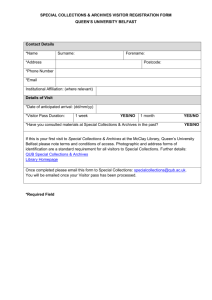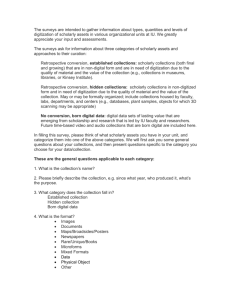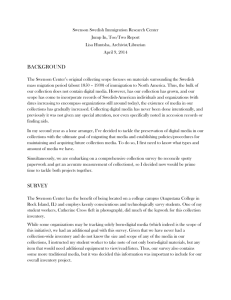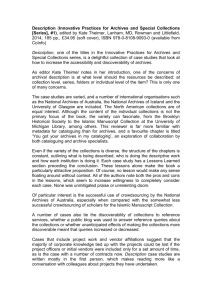read the complete policy
advertisement
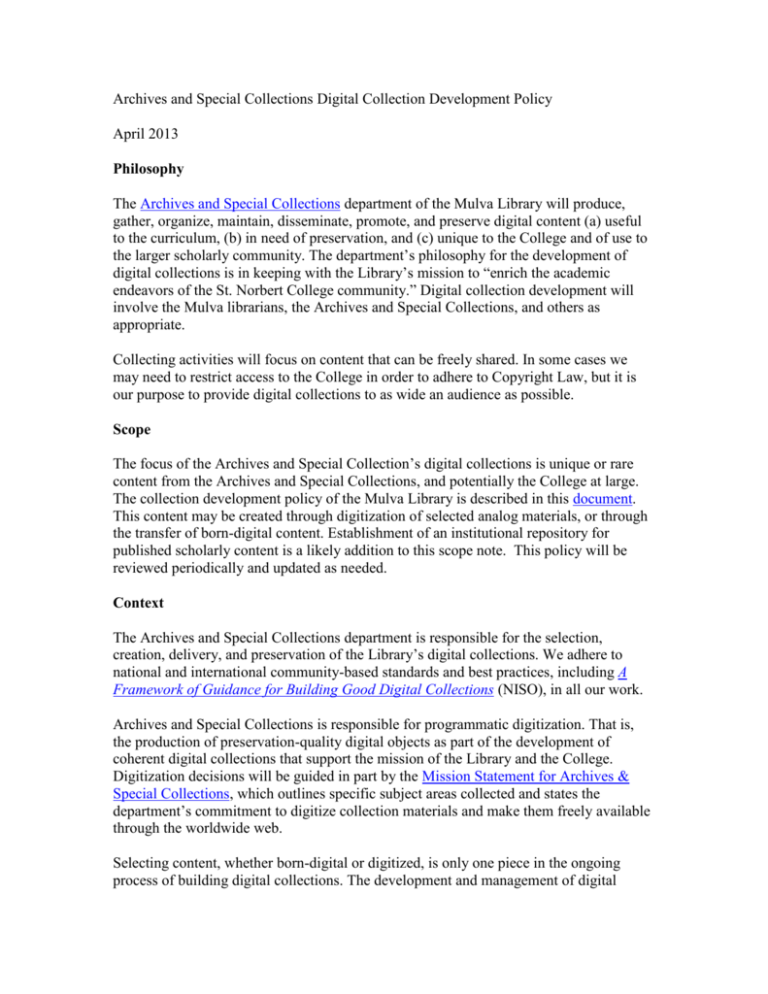
Archives and Special Collections Digital Collection Development Policy April 2013 Philosophy The Archives and Special Collections department of the Mulva Library will produce, gather, organize, maintain, disseminate, promote, and preserve digital content (a) useful to the curriculum, (b) in need of preservation, and (c) unique to the College and of use to the larger scholarly community. The department’s philosophy for the development of digital collections is in keeping with the Library’s mission to “enrich the academic endeavors of the St. Norbert College community.” Digital collection development will involve the Mulva librarians, the Archives and Special Collections, and others as appropriate. Collecting activities will focus on content that can be freely shared. In some cases we may need to restrict access to the College in order to adhere to Copyright Law, but it is our purpose to provide digital collections to as wide an audience as possible. Scope The focus of the Archives and Special Collection’s digital collections is unique or rare content from the Archives and Special Collections, and potentially the College at large. The collection development policy of the Mulva Library is described in this document. This content may be created through digitization of selected analog materials, or through the transfer of born-digital content. Establishment of an institutional repository for published scholarly content is a likely addition to this scope note. This policy will be reviewed periodically and updated as needed. Context The Archives and Special Collections department is responsible for the selection, creation, delivery, and preservation of the Library’s digital collections. We adhere to national and international community-based standards and best practices, including A Framework of Guidance for Building Good Digital Collections (NISO), in all our work. Archives and Special Collections is responsible for programmatic digitization. That is, the production of preservation-quality digital objects as part of the development of coherent digital collections that support the mission of the Library and the College. Digitization decisions will be guided in part by the Mission Statement for Archives & Special Collections, which outlines specific subject areas collected and states the department’s commitment to digitize collection materials and make them freely available through the worldwide web. Selecting content, whether born-digital or digitized, is only one piece in the ongoing process of building digital collections. The development and management of digital collections also involves project management and strategic planning; metadata creation and management; the development and use of systems to create, manage, preserve, and deliver digital content; and the ongoing assessment of digital collections and services. The success of these activities will hinge upon collaboration. We will work closely with other units in the Library to realize our goals, and will collaborate with other units in the College and with external institutions and organizations as appropriate. Selection Factors Although the following criteria refer to selecting content for digitization, the same factors will be applied when selecting born-digital materials. Because we will not have oversight for the creation of born-digital materials, greater attention will also need to be paid to evaluation of their technical characteristics and other factors related to our ability to preserve those materials digitally. Copyright Status Most material considered for digitization will fall into one of the following categories: Works in the public domain Works for which St. Norbert College holds the copyright Works for which we have obtained permission to digitize We may also digitize materials determined to be Orphan Works, i.e., works for which the copyright holder cannot be located. Significance of the Materials The significance of content is a subjective judgment, and requires the evaluation a number of factors. We will consider these questions: Would experts confirm the importance of the materials? How are the materials currently used? What impact might digitization have on use? Do the materials complement existing digital content? Will digitization of the materials enhance their intellectual value? Current and Potential Users The following use factors may indicate good candidates for digitization: Materials receive heavy use Physical condition or current access of the originals limit use Electronic access would enhance value to users Materials are dispersed Organization and Metadata Regardless of the importance of a collection, it must be organized and described before it can be digitized. Books must be cataloged. Archives and manuscript materials must be processed and have a finding aid, though item-level metadata may be created as part of the development of the digital collection. Metadata must follow community-based standards, as well as guidelines developed by the Archives and Special Collections department. Software platforms will be utilized with existing programs and in collaboration with other departmental needs. Relationship to Other Collections Materials that build on existing digital collections, whether at St. Norbert College or elsewhere, can improve research in a specific subject area and increase the research value of the materials themselves. Potential for collaborative collection building is an important factor to consider. Funding Sources Donors and grant-making agencies may stipulate funding priorities that impact digitization. Matching high-priority materials to appropriate funding sources is crucial. Limitations Materials that meet digitization criteria will not be digitized if they: Cannot be shared without violating copyright law. (see above for details) Are duplicative of material digitized elsewhere, so long as the existing digital object follows the characteristics of good digital objects as outlined in the NISO Framework and is broadly accessible. Do not comprise a complete work. (e.g., a single page from a book) Digitization Digitization activities will likely fall into one of three categories: Ongoing digitization of entire collections or large portions of collections. Ongoing digitization is done by Archives and Special Collections staff and student workers. These projects are generally not subject to specific deadlines. Specially-funded digitization projects made possible through grants or gifts. These may involve additional short-term staff and will likely be subject to specific deadlines and special project parameters. Digitization based on user requests of materials that are rare or unique, fit the selection criteria, and receive regular use. This includes material requested by researchers in the archives, by faculty for teaching purposes, and by users through Interlibrary Loan. Although single-purpose digitization is necessary, it is not the focus of our digital collection development, and these materials will be evaluated according to the same criteria as other digitization projects. Maintenance and Removal This policy is designed in part to ensure the development of digital collections that are of high-quality, useful and usable, and cohesive. It is possible, however, that individual objects or entire collections may need to be removed or de-accessioned for reasons of collection weeding, storage, or copyright dispute, among others. These decisions will be made in conjunction with the Mulva Librarians, Archives and Special Collections, and others as appropriate.


